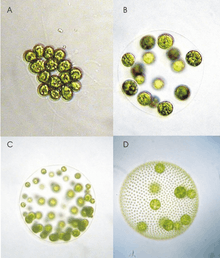Chlamydomonadales
| Chlamydomonadales | |
|---|---|
 | |
| (A) Gonium pectorale, (B) Eudorina elegans, (C) Pleodorina californica, and (D) Volvox carteri | |
| Scientific classification | |
| (unranked): | Viridiplantae |
| Class: | Chlorophyceae |
| Order: | Chlamydomonadales Fritsch in West & Fritsch, 1927 |
| Families | |
| Synonyms | |
| |
Chlamydomonadales, also known as Volvocales, are an order of flagellated or pseudociliated green algae, specifically of the Chlorophyceae.[1] Chlamydomonadales can form planar or spherical colonies. These vary from Gonium (four to 32 cells) up to Volvox (500 cells or more). Each cell has two flagella, and is similar in appearance to Chlamydomonas, with the flagella throughout the colony moving in coordination.
Both asexual and sexual reproduction occur. In the former, cells divide until they form new colonies, which are then released. In the smaller forms, typically all cells are involved, but larger forms have anterior vegetative and posterior reproductive cells. Sexual reproduction varies from isogamy (both genders produce flagellated gametes of equal size) to oogamy (one gender produces a much larger, nonmotile gamete).
The classification of the Chlamydomonadales varies. Very often they are taken to include the orders Volvocales and Dunallielales, which contain closely related unicellular flagellates, as suborders.
References
- ↑ See the NCBI webpage on Chlamydomonadales. Data extracted from the "NCBI taxonomy resources". National Center for Biotechnology Information. Retrieved 2007-03-19.
External links
- Guiry, M.D.; Guiry, G.M. (2018). "Chlamydomonadales". AlgaeBase. World-wide electronic publication, National University of Ireland, Galway.